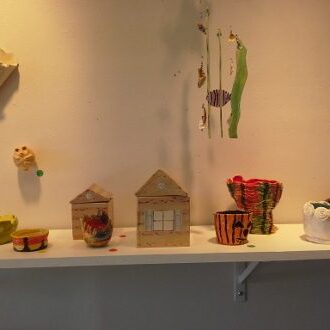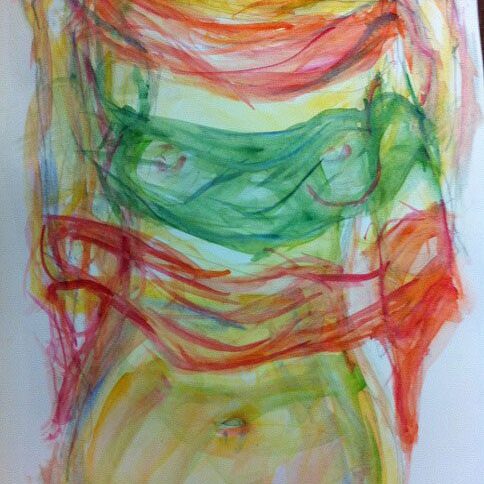
ART CLASSES
Program staff, visiting artists and advanced level members provide mentoring to ensure that membership remains engaged as we introduce new concepts and skills. Staff teaching intermediate instruction ensures that content retains course integrity and members’ interests.
Art classes that do not promote current critical and creative thinking skills may prevent members from exploring and expressing individual ideas, thoughts, or emotions; and may even delay a desire to participate in wellness activities or support groups. Our program standards focus on our members current capabilities, willingness to learn new skills and a desire to maintain their health & wellness.
CLAY TECHNIQUES
The ceramics classes are all about fundamentals. Using a low-fire earthenware clay and over glazes makes this a perfect class for beginners. But a full-blown Bernini does not happen overnight. In this class members will concentrate on learning and putting into practice the three common methods of hand building: the pinch method, coil method, and slab method.
Through practice and experimentation, participants will build their knowledge base, collecting techniques along the way, that will help them to design and construct functional and non-functional ceramic artwork. A high the level of commitment and participation will lead to a greater degree of complexity and yield better artisanship in the final product.


WATERCOLOR
Watercolor is sometimes referred to as a Master Medium. However, painting with watercolors can be difficult. As a light translucent medium, its delicate quality can be unforgiving and unpredictable. Since mistakes are difficult to correct, and its fluid nature makes it hard to control, a watercolor painter must begin with a good solid knowledge base of brushes and techniques. Classes will include lessons focusing on wet-in-wet application, layering washes and transparencies, dry and wet applications, Gradients, and Spattering. These are just a few examples of such techniques that make this such a unique medium.
PASTELS
Members interested in broadening their knowledge of fine art by incorporating the element of color may want to consider the medium of pastel. Mant artists feel they are a logical next step from drawing with graphite and provide a clear path to acrylic painting. Pastels are a drawing medium that come in every color imaginable. They are easily blended into beautiful gradients. Pastels are made by mixing dry pigment with a gum binder and some filler to form a thick paste, which is fashioned into sticks and allowed to dry. Pastel paper is preferred to use because of the texture, or tooth, that is great for catching the pigment as it is applied to the paper.


ACRYLIC PAINTING
9Muses painting class focuses on the medium of acrylic paint for beginning and intermediate level artists. Members will learn the fundamentals of acrylic painting and introductory color theory. Lessons such as mixing acrylic paint colors, types of brushes and their uses, mark making (drawing with a brush), and making 3-D forms on flat canvas will be explored. Many different references may be used including still life arrangements, photographs, and even our own bodies. Members will be encouraged to produce interesting compositions using their own ideas and references by employing techniques like cropping, dynamic symmetry, and limited color palettes.
DRAWING
The drawing class at 9Muses aims to teach members the basic skills and principles needed to render objects in graphite. In this class members will learn about basic concepts such as composition, the Elements of Art, and the Principles of Design.
Many different tools will be explored, such as vine and compressed charcoal, several types of erasers, blending sticks, and fixative. The ability to decipher shadows from mid tones and highlights, how to accurately draw proportions, achieve perspective, foreshorten subject matter, and recognize edges and angles will allow us to become a proficient graphite artist.
These fundamentals work as tools for future artistic endeavors carrying over into other mediums including pastel, watercolor, and acrylic painting. Through practice, learning and integrating these concepts allow for maximum creativity and expression. Whether following these concepts or going against them, utilizing them can only improve the creative process.


PERFORMING ARTS
Members who want to learn or improve their skills in guitar, percussion, piano, and voice will find instruction in our Music Class. Sessions are typically done on a one-to-one or singular instrument basis. Class is open to complete beginners and experienced musicians alike. Other instruments and skills can be added in communication with instructor. Come jam with us!
ACTING:
Perfect for those with a dramatic flair, our Acting Class is a dynamic course on the performing arts. Participants will learn and practice the basics such as public speaking, body awareness, vocal strength, performance composition, character creation, and more! Participants are invited to engage in group performances in and out of class. Open to both the shyest of beginners to expert dramatists.
CREATIVE WRITING
For those interested in exploring their literary talents, our Creative Writing Class offers the opportunity to discover and produce different modes of writing. These include fiction, narrative, creative non-fiction, poetry, and more! Classes are made to work with different skill and experience levels. Members are encouraged to participate with creative works and feedback.

Critique & Explore
Cri·tique /kriˈtēk/
Noun; a detailed analysis and assessment of something, especially a literary, philosophical, or political theory.
Verb; evaluate (a theory or practice) in a detailed and analytical way.
"the authors critique the methods and practices used in the research"
Ex·plore /ikˈsplôr/
Verb
travel in or through (an unfamiliar country or area) in order to learn about or familiarize oneself with it.
search for resources such as mineral deposits.
inquire into or discuss (a subject or issue) in detail.
"he sets out to explore fundamental questions"
Bring your artwork, old, new, unfinished, barely thought of, and let it be placed on a comfy chopping block of your peers and creative equals and softly cut to small bits where soon after it will be stitched back together with delicate refinement.
What we mean is it helps to run your ideas by other humans. The critique process isn’t always painful, but it is always helpful if you allow it to be. Being able to defend your artwork is what makes it worth something. Give your creativity weight by being able to guide viewers through your world and become a better creative by being able to believe in yourself and be objective.
